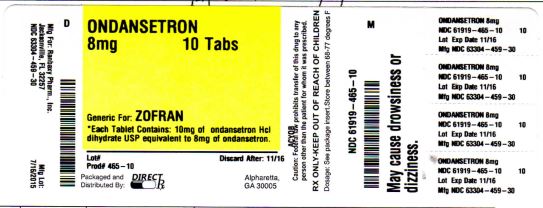Drug Catalog - Product Detail
ONDANSETRON HYDROCHLORIDE TB 8MG 30
| NDC | Mfr | Size | Str | Form |
|---|---|---|---|---|
| 63304-0459-30 | SUN PHARMACEUTICALS | 30 | 8MG | TABLET |
PACKAGE FILES


Generic Name
Substance Name
Product Type
Route
Application Number
Description
DESCRIPTION SECTION The active ingredient in Ondansetron Tablets, USP is ondansetron hydrochloride (HCl) as the dihydrate, the racemic form of ondansetron and a selective blocking agent of the serotonin 5-HT receptor type. Chemically it is (±) 1, 2, 3, 9-tetrahydro-9-methyl-3-[(2-methyl-1H-imidazol-1-yl)methyl]-4H-carbazol-4-one, monohydrochloride, dihydrate. It has the following structural formula: Ondansetron HCl dihydrate is a white to off-white powder that is soluble in water and normal saline. Each 4 mg ondansetron tablet, USP for oral administration contains ondansetron hydrochloride, USP equivalent to 4 mg of ondansetron. Each 8 mg ondansetron tablet, USP for oral administration contains ondansetron hydrochloride, USP equivalent to 8 mg of ondansetron. Each tablet also contains the inactive ingredients croscarmellose sodium, hypromellose, lactose monohydrate, magnesium stearate, microcrystalline cellulose, pregelatinized starch, titanium dioxide, triacetin, and iron oxide yellow (8 mg tablet only). Product meets USP Drug Release Test 3. image description
How Supplied
HOW SUPPLIED SECTION Ondansetron tablets, USP 4 mg (ondansetron hydrochloride, USP equivalent to 4 mg of ondansetron), are white, oval, film-coated tablets debossed with "4" on one side and “NO” on the other side. They are supplied as follows: NDC 63304-458-30 Bottles of 30 Ondansetron tablets, USP 8 mg (ondansetron hydrochloride, USP equivalent to 8 mg of ondansetron), are yellow, oval, film-coated tablets, debossed with "8" on one side and "NO" on the other side. They are supplied as follows: NDC 63304-459-30 Bottles of 30 Store at 20° to 25°C (68° to 77°F). (See USP Controlled Room Temperature). Dispense in a tight, light-resistant container as defined in the USP.
Indications & Usage
INDICATIONS & USAGE SECTION Prevention of nausea and vomiting associated with highly emetogenic cancer chemotherapy, including cisplatin ≥ 50 mg/m2. Prevention of nausea and vomiting associated with initial and repeat courses of moderately emetogenic cancer chemotherapy. Prevention of nausea and vomiting associated with radiotherapy in patients receiving either total body irradiation, single high-dose fraction to the abdomen, or daily fractions to the abdomen. Prevention of postoperative nausea and/or vomiting. As with other antiemetics, routine prophylaxis is not recommended for patients in whom there is little expectation that nausea and/or vomiting will occur postoperatively. In patients where nausea and/or vomiting must be avoided postoperatively, ondansetron tablets, USP are recommended even where the incidence of postoperative nausea and/or vomiting is low.
Dosage and Administration
DOSAGE & ADMINISTRATION SECTION Prevention of Nausea and Vomiting Associated With Highly Emetogenic Cancer Chemotherapy The recommended adult oral dosage of ondansetron tablets, USP is 24 mg given as three 8-mg tablets administered 30 minutes before the start of single-day highly emetogenic chemotherapy, including cisplatin ≥ 50 mg/m . Multiday, single-dose administration of a 24 mg dosage has not been studied. There is no experience with the use of a 24 mg dosage in pediatric patients. The dosage recommendation is the same as for the general population. Prevention of Nausea and Vomiting Associated With Moderately Emetogenic Cancer Chemotherapy The recommended adult oral dosage is one 8-mg ondansetron tablet, USP given twice a day. The first dose should be administered 30 minutes before the start of emetogenic chemotherapy, with a subsequent dose 8 hours after the first dose. One 8-mg ondansetron tablet, USP should be administered twice a day (every 12 hours) for 1 to 2 days after completion of chemotherapy. For pediatric patients 12 years of age and older, the dosage is the same as for adults. For pediatric patients 4 through 11 years of age, the dosage is one 4-mg ondansetron tablet, USP or one 4-mg given 3 times a day. The first dose should be administered 30 minutes before the start of emetogenic chemotherapy, with subsequent doses 4 and 8 hours after the first dose. One 4-mg ondansetron tablet, USP should be administered 3 times a day (every 8 hours) for 1 to 2 days after completion of chemotherapy. The dosage is the same as for the general population. Prevention of Nausea and Vomiting Associated With Radiotherapy, Either Total Body Irradiation, or Single High-Dose Fraction or Daily Fractions to the Abdomen The recommended oral dosage is one 8-mg ondansetron tablet, USP given 3 times a day. For total body irradiation, one 8-mg ondansetron tablet, USP should be administered 1 to 2 hours before each fraction of radiotherapy administered each day. For single high-dose fraction radiotherapy to the abdomen, one 8-mg ondansetron tablet, USP should be administered 1 to 2 hours before radiotherapy, with subsequent doses every 8 hours after the first dose for 1 to 2 days after completion of radiotherapy. , one 8-mg ondansetron tablet, USP should be administered 1 to 2 hours before radiotherapy, with subsequent doses every 8 hours after the first dose for each day radiotherapy is given. There is no experience with the use of ondansetron tablet, USP in the prevention of radiation-induced nausea and vomiting in pediatric patients. The dosage recommendation is the same as for the general population. Postoperative Nausea and Vomiting The recommended dosage is 16 mg given as two 8-mg ondansetron tablets, USP 1 hour before induction of anesthesia. There is no experience with the use of ondansetron tablets, USP in the prevention of postoperative nausea and vomiting in pediatric patients. The dosage is the same as for the general population. Dosage Adjustment for Patients With Impaired Renal Function The dosage recommendation is the same as for the general population. There is no experience beyond first-day administration of ondansetron. Dosage Adjustment for Patients With Impaired Hepatic Function In patients with severe hepatic impairment (Child-Pugh score of 10 or greater), clearance is reduced and apparent volume of distribution is increased with a resultant increase in plasma half-life. In such patients, a total daily dose of 8 mg should not be exceeded.
